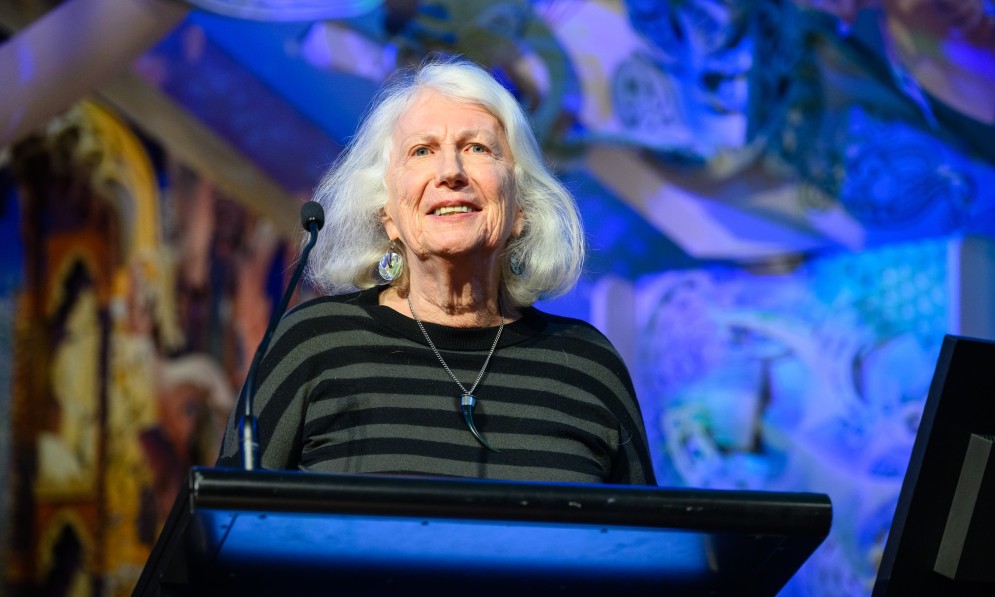On Saturday 29 July 2023, Dame Anne Salmond delivered her Sanderson Lecture at the Sanderson Dinner (following Forest & Bird's Centennial Conference).
Ko te wai e hora nei, ko Raukawamoana
Ko te marae e takoto nei, ko Te Papa Tongarewa
Ko koutou aku rangatira kua pae nei, tēnā koutou, tēnā koutou katoa.
First of all, congratulations on turning 100 years old. As Royal Forest and Bird, I guess you’re entitled to expect a telegram from the King! It’s a time for deep reflection about this organisation’s beginnings, what it stands for, and what Forest and Bird hopes to achieve over the next 100 years.
Captain Val Sanderson, Forest and Bird’s founder, was passionate about protecting New Zealand’s indigenous forests, and the creatures that live in them. After fighting in the Boer War and WWI, he declared war on invasive species, including goats, deer and wild pigs. He’d be horrified to hear that the National Party has just pledged that if they win this election, game animals including deer and pigs will no longer be classified as pests.
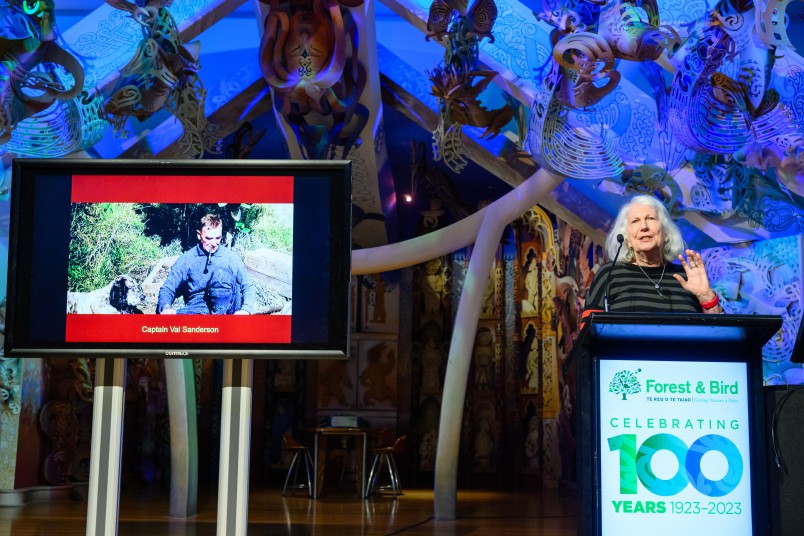
Image Mark Coote
Given the devastating impacts of these animals on our indigenous forests, one of Forest and Bird’s first tasks for its next century must surely be to challenge whoever came up with this brilliant idea. Conservative parties need to know what’s worth conserving, and I’m sure National must realise that we are in the midst of a global biodiversity crisis, with species collapsing all over the planet and a very good chance that Homo Sapiens will join them.
For New Zealand is a biodiversity hotspot, with one of the worst extinction rates on the planet. Our beautiful islands lie at the heart of the world’s largest ocean, and this was one of the last places on earth to be found and settled by human beings. Before the first people came ashore, life forms had been co-adapting in isolation here for about 85 million years, creating an extraordinary array of endemic species including flightless birds, giant snails and walking bats.
As Jared Diamond has observed, examining the New Zealand biota is the closest “we will get to the opportunity to study life on another planet.” We now know that the ancestors of many of these creatures flew, floated or were blown here. They had to survive a long, difficult oceanic or airborne journey, and adapt to environments very different from their homelands. As they moved into new niches, this sparked rapid innovation and the emergence of new species.
Something similar seems to have happened in the case of human beings. Our ancestors had to be courageous and innovative to get here. In order to reach this remote archipelago, for instance, the ancestors of Maori had to invent blue water sailing (a legacy we’re still exploring)
When the first star navigators from island Polynesia landed about seven hundred years ago, New Zealand became the last significant land mass on earth to be found and settled by human beings. They had to quickly adapt to landscapes very different from their tropical island homelands.
Far from being a static, steady state ‘traditional’ society, then, Maori life was dynamic and rapidly changing. In the 450 years before European arrival, Maori invented a new language, cosmology and art forms, fashioned new kinds of watercraft and buildings, and mastered new fibre, stone and agricultural technologies.
Sometimes they made mistakes, setting fires that ran out of control and exploiting some local species to the point of extinction, including the moa, their best source of protein. Nevertheless, the rate of successful innovation was impressive. Different ways of life, products and ideas emerged in different parts of the country.
In Maori philosophy, all the world is a vast kin network. In this relational cosmos, Earth and Sky, sea, stars, winds, people and other life forms are linked together, locked in reciprocal exchanges. When balance is achieved, the networks of relations in families, communities and ecosystems alike are in a state of ora or well-being – healthy, prosperous and in good heart.
If reciprocity falters, however, entire networks and their members begin to fail and become mate or sick – unhealthy and dysfunctional – a state that can apply to families, communities, forests, lakes, rivers and the ocean, as well as individuals; even whole nations and the planet.
Like the first Polynesian voyagers, the first Western explorers who arrived in New Zealand, Abel Tasman and Captain James Cook, faced formidable challenges. In order to cross the Pacific and reach these remote islands, European mariners had to perfect the art of sailing for long periods over great distances.
In 1769 when the Endeavour made its landfall on the East Coast of NZ, the scientists on board thought that they had discovered Terra Australis Incognita, the Unknown Southern Continent, fabled to be rich in gold, silver, pearls and spice, and with rajahs riding around on elephants. Instead it turned out to be my home town of Gisborne.
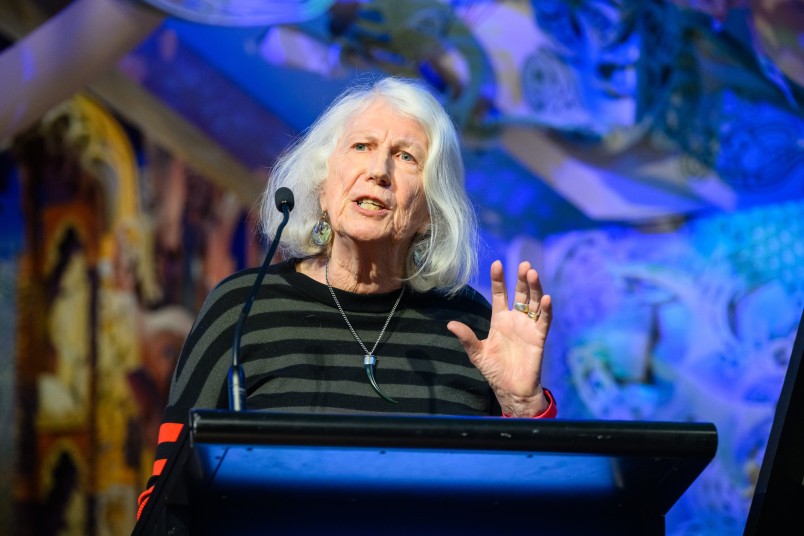
Image Mark Coote
At that time, life in Europe was in a phase of explosive innovation. Modernity began in Europe in the 1760s. The Royal Society of London, which had sponsored James Cook’s expedition, was at the cutting edge of the Enlightenment, characterised by many new inventions in the arts, manufacturing, agriculture, governance and science.
Some of these innovations were revolutionary – struggles for the rights of commoners, women and indigenous people, for instance, and a fascination with understanding every aspect of life in the cosmos and on earth, including plants and animals.
At the same time, though, the old cosmic hierarchies were enduring; and the Endeavour carried a cargo of colliding cosmologies. You can see this from Captain Cook’s instructions – on the one hand, orders from the Admiralty to claim the sovereignty of any new lands he might discover; on the other, ‘Hints’ from the Royal Society that indigenous peoples enjoyed the sovereignty of their own lands, and that this must be respected.
These contradictory legacies are still playing out in our history – the old idea of the Great Chain of Being from Europe, for instance, with God at the top of the Chain, over angels and archangels and a divine sovereign (the origins of ‘sovereignty’), with aristocrats over commoners, men over women, ‘civilised’ over indigenous people, ‘culture’ over ‘nature’ and human beings over all other life forms.
It was these kinds of ideas that led to the war we declared on our indigenous forests and landscapes, destroying the habitat of so many species; and the Land Wars, for that matter.
Alongside all of this, there were dreams of more egalitarian ways of living, a willingness to tackle existential challenges and an experimental spirit. My own ancestors from the Western Isles of Scotland had a fascination with genealogy and ancestral stories that resonate closely with the idea of whakapapa, that cosmic web of life in which Ranginui and Papatūanuku and their offspring, the winds, forests, oceans and rivers are more ancient and powerful than people.
Here, the earth is a whenua rangatira, a rangatira in her own right; a mother to be cared for and respected. As the old proverb says, toitū te whenua, whatungarongaro te tangata – as people come and go, the land always stands.
This vision offers a compelling alternative to the extractive, anthropocentric philosophies that are currently putting human survival at risk. By recognising the Whanganui River and the Urewera as beings with their own life and rights, and in te mana o te wai, for instance, we have begun to give this kind of vision some legal standing in Aotearoa NZ.
As Tamati Kruger from Tūhoe said recently, “My iwi is a kinship organisation … not a business. What we’ve done is ... declared war on certain beliefs that human beings have adopted, such as that land is no longer Mother Earth, it’s property … There is this view that nature is a helpless damsel. We own it and it depends on us. No, it’s the other way around.
It’s an old belief, isn’t it, that comes from you and I, and it talks about our whakapapa to the land, our kinship to the land. Something that I believe many, many New Zealanders are proud of, and aware of, and easily grasp – that philosophy and that belief.”
Tamati also denounces what he calls ‘imposter tikanga’ – tikanga that wrap up extractive activities in talk of kai-tiakitanga, for instance. Instead, he and others are fighting for ‘nature-based solutions’ grounded in whanaungatanga, and rooted in this land.
Think, for instance, of the cloak that Tāne Mahuta wrapped around his mother after their children separated her from Ranginui, Sky Father, leaving her bare and naked. According to a recent research paper, during Cyclone Gabrielle in Tairāwhiti, indigenous forests held the land together five times better than pine plantations, and ten times better than harvested plantations. There are similar findings from the Malborough Sounds.
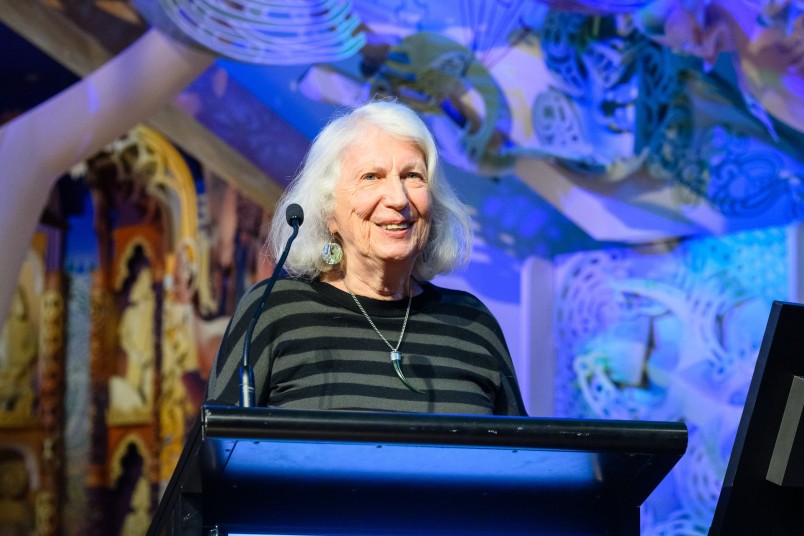
Image Mark Coote
Not only that, but according to climate scientist Tim Flannery, Aotearoa’s temperate rain forests are among the best carbon sequestering ecosystems on the planet, even better than the Amazon. At a time of biodiversity collapse as well as climate change, why wouldn’t we use our indigenous forests to restore balance to our whenua? Why on earth are we using short-lived, shallow rooting, highly flammable exotic monocultures instead?
That is a very good question. For the past 25 years, my husband Jeremy and I have been restoring 120 hectares of steep, highly erodible hill country at Waikereru, 9 kilometers north of Gisborne. Jem died in early January, and a week later Cyclone Hale hit Waikereru, followed soon afterwards by Cyclone Gabrielle.
During Cyclone Gabrielle, the land and the rivers were screaming. Despite this, the hills on our land, cloaked in regenerating bush, held together, while on the opposite side of the river, the steep slopes in pasture collapsed. Upriver, plantations of 10-12 year old pine trees fell over like ninepins and were swept downstream, along with vast rafts of forestry slash.
Across a bend just upstream from Waikereru, a huge pile of logs jammed the Waimatā river, and then burst; taking our riverside fence and plantings with it. Only Longbush, a prized stretch of rare mature alluvial forest, stood tall against the flood. In Donner’s Bush, a DoC Scenic Reserve next to Waikereru, those sections of the bush that had been fenced held together, while the unfenced sections fell into the river, taking the road with it.
All of this has been heartbreaking, but it’s nothing compared with what happened to so many other people in our region. Forestry slash has destroyed fences, farm buildings and paddocks; orchards, vineyards and crops; roads; bridges and access to hospitals, schools and workplaces; homes and whole communities; rivers, harbours and beaches; livelihoods and lives.
One industry, placed on steroids by the Emissions Trading Scheme and wrong-headed environmental thinking, devastated almost every other community activity and business in the region. This is what happens when you don’t follow nature-based solutions, or listen to the land.
So, what is the way forward? Whanaungatanga, I think – with each other, and these glorious islands. Let’s focus on the ties that bind us with each other, and the whenua, awa and the moana, weaving our lives together. And let’s be courageous, and active. This is the only reason that Forest and Bird exists – to take care of each other, and our beautiful land.
We can all find our projects, in which good people come together to transform the future. As the anthropologist Margaret Mead once said, ‘Never doubt that a small group of thoughtful, committed citizens can change the world. Indeed, it’s the only thing that ever has.’
Mine are at Waikereru; and in a world-leading project called ‘Recloaking Papatūanuku’ with Pure Advantage, Mana Taiao Tairāwhiti and a host of other partners. Here, we aim to restore 2 million hectares of indigenous forest on eroding hillsides and gullies and around waterways across the country, cleansing streams and rivers, providing homes for our unique plants and animals while sequestering carbon for centuries, long into the future.
Our children and grandchildren deserve hope and optimism, not counsels of despair.
In Aotearoa New Zealand, our waterways are being ravaged, choked with sediment and slash. Let’s hear them sing again. In the wide ocean that surrounds us, polluted with plastic and other junk, overfished, and heating with climate change, Tangaroa is calling. In the Kermadecs and elsewhere, let’s protect the waters, and hear the song of the whales.
Indigenous forests and their birds inspired the creation of this organisation, one hundred years ago, but they are falling silent. Let’s fight to take care of them, our whanaunga; realising that we are just one life form among many. The extinction crisis is a risk to us all, not just to other species.
In Aotearoa New Zealand, our small, intimate society, we have led the world before. We can do it again.
It was great to hear from Nicola Toki that the tui used to feature on the Forest and Bird logo. Here’s a message from that manu kōrero:
Whakarongo! Whakarongo! Whakarongo ki te tangi a te manu e karanga nei,
Tui, tui, tui, tuituiaa!.....
Listen, listen, listen, to the cry of the bird calling
Bind, join, be one!
Bind above, bind below, bind within, bind without
Tie the knot of humankind!
Bind the lines of people coming down from great Hawaiki, long Hawaiki, Hawaiki far away
Bind to the spirit, to the daylight, to the world of light!
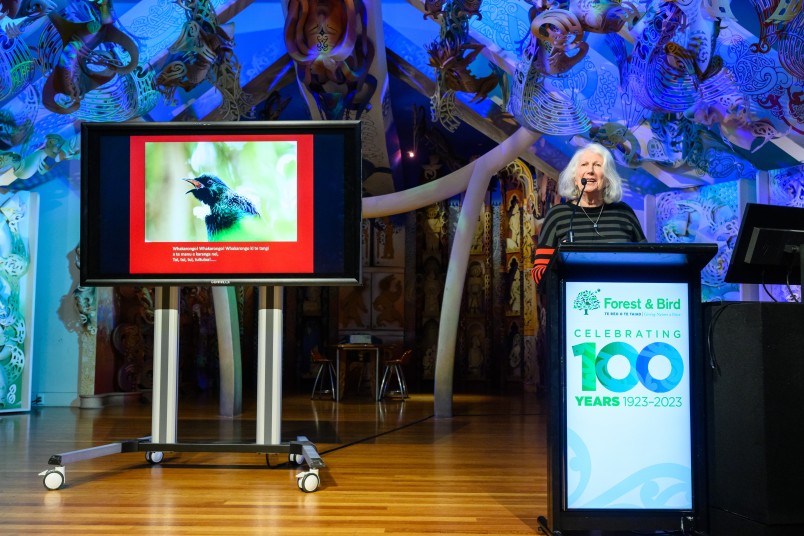
Image Mark Coote

